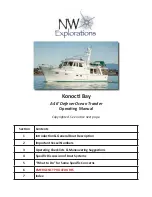
INSTRUCTIONS
To eliminate unnecessary work, careful reading of the applicable section is recommended before starting to service a
bumper boat. Photographs, diagrams, notes, cautions, warnings, and detailed descriptions have been included wherever
necessary. Nevertheless, even a detailed account has limitations; a certain amount of basic knowledge is also required for
successful work.
ESPECIALLY NOTE THE FOLLOWING:
DIRT
Before removal and disassembly, clean the bumper boat. Any dirt entering the engine or other parts will work as an
abrasive and shorten the life of these parts. For the same reason, before installing a new part, clean off any dust or metal
filings.
TIGHTENING SEQUENCE
Generally, when installing a part with several bolts, nuts or screws, start them all in their appropriate holes and tighten
them to a snug fit. Then tighten them evenly in a cross pattern. This will avoid distortion of the part. Conversely, when
loosening the bolts, nuts or screws, loosen by a quarter turn, and then remove. Where there is a tightening sequence
indication in this Service Manual, the bolts, nuts or screws must be tightened in the order and method indicated.
TORQUE
When torque values are given in this Service Manual, use them. Either too little or too much torque may lead to serious
damage. Use a good quality, reliable torque wrench.
FORCE
Common sense should dictate how much force is necessary in assembly and disassembly. If a part seems especially
difficult to remove or install, stop and examine what may be causing the problem. Whenever tapping is necessary, tap
lightly using a wooden or plastic-faced mallet. Use an impact driver for screws (particularly for the removal of screws held
by a locking agent) in order to avoid damaging the screw heads. It may also be necessary to apply heat to some parts that
are held with locking compound.
EDGES
Watch for sharp edges, especially during major motor/engine disassembly and assembly. Protect your hands with gloves
or a piece of thick cloth when lifting the motor/engine, or when turning it over.
HIGH-FLASH-POINT SOLVENT
A high-flash-point solvent is recommended to reduce fire danger. A commercial solvent commonly available in North
America is “Standard solvent” (generic name). Always follow manufacturer and container directions regarding the use of
any solvent.
GASKET, O-RING
Do not reuse a gasket or O-ring once it has been in service. The mating surfaces around the new gasket should be free of
foreign matter and perfectly smooth.
LIQUID GASKET, NON-PERMANENT LOCKING AGENT
Follow manufacturer’s directions for cleaning and preparing surfaces where these compounds will be used. Apply sparingly,
As excessive amounts may cause serious damage. An example of a non-permanent locking agent commonly available in
North America is Loctite® Lock’n Seal (Blue).
PRESS
A part installed using a press or driver, such as a wheel bearing, should first be coated with oil on its outer or inner
circumference so that it will go into place smoothly.
OIL SEAL AND GREASE SEAL
Replace any oil or grease seals that were removed with new parts, since removal generally damages seals. When pressing
in a seal containing manufacturer’s marks, press it in with the marks facing out. Seals should be pressed into place using a
suitable driver (which contacts evenly with the side of the seal) until the face of the seal is even with the end of the hole.
Always use assembly oil or grease on the lip (sealing edge) of any seal prior to assembly.
Содержание Bumper Boat 2014
Страница 6: ...0 6 NOTES ...
Страница 90: ...3 2 MOTOR COVER General Information 3 2 Motor Cover And Neoprene Protector 3 3 ...




































